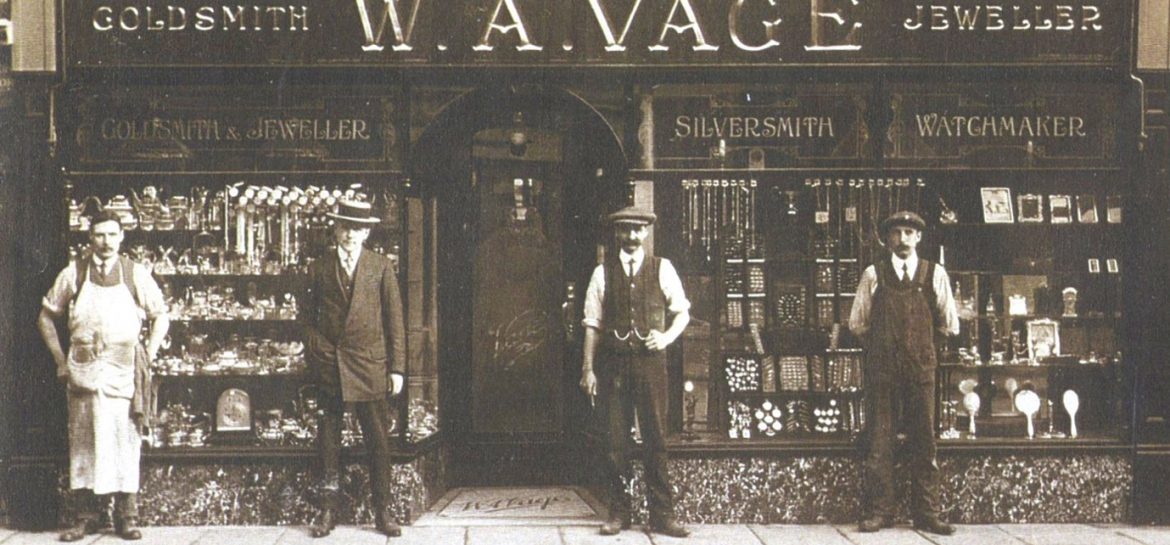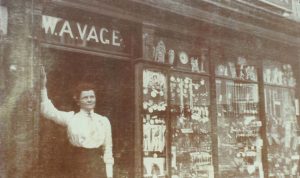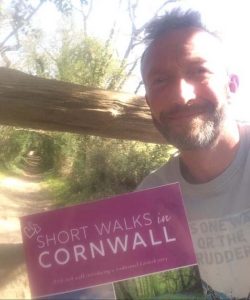
The Vage family were well-known in the Truro business community and here, Simon Vage, brings us their story with emphasis on W A Vage, Jeweller.
The end of the 19th Century was a golden period for the Vage Family, as it was for many of Cornwall`s families.
As with so many natives of Cornwall, the world was our oyster, and many of the Vage males sailed from these shores to try their hand at mining and settlement overseas in New Zealand, Australia, South Africa, Canada and North America. Most did settle and have raised Cousin Jacks and Jennys on distant continents. One however, following 15 years of travel, returned to his native Cornwall (along with his Cornish wife) and settled down in his home town of Truro, alongside two of his brothers who had recently returned from their overseas service in the British Army.
At a time where you made your own way in the world, all three brothers embarked on their own businesses: one as a dairyman with stables in Calenick Street, the second as a cab man in Quay Street, and the third (my direct ancestor) as a wood turner.
This wood turner was called John Henry Vage and had used his carpentry skills to work his way around the world (Australia, America, New Zealand, Hong Kong and Burma). As the century drew to a close he opened his doors for business in what is now City Road (named at that time ‘Back Lane’). John Henry Vage cut an imposing figure who unusually for the time, was a large Cornishman unlike all his brothers. He became the head of a burgeoning family. Into all of his children, he and his wife Mary instilled a work ethic which enabled both their sons to forge paths of varying industry and their daughters to play important roles. The latter at a time where women were still seen as inferior citizens. (Without these female members of the family, the longest standing of the Vage businesses would not have survived the war years.
The wood turning business ran for two generations, when John Henry`s son (also called John) joined him in this trade and continued running it after his father`s death, although by this time the business had relocated to Kenwyn Street. Specialising in mangles and household implements, the business ran from the 1880s through to the 1950s in spite of the fact that the younger John Vage had lost both his legs through illness. John himself had just the one son, yet instead of following his father`s profession, he followed his uncle`s and became a jeweller.
John Henry Vage`s eldest son had been born whilst the family were still working their way around the world (in New York) and as soon as he was of age, he left Cornwall and returned to America. Whilst there, he trained as a master baker and confectioner, before returning to Truro in the 1890s to establish his own bakery and confectionery business in Carclew Street. Here he married and had three children, one of whom would also follow his uncle and become a jeweller later in life. After successfully running this business up to circa 1908, he again left Cornwall and returned to America where he settled down and never returned home.
John Henry Vage`s youngest son is my direct ancestor and is the one about whom I have specifically been asked to put down some business thoughts. His name was William Albert Vage and his story of business starts in 1902
In this year, a silversmiths and watchmakers in New Bridge Street (Samuel Bolitho) was put up for sale. This business had been established in 1889, but the owner now needed to sell up. William had had an apprenticeship in Plymouth, when his father told him about an opportunity not only to move home but also to become his own master. Being an opportunity too good to miss, William was loaned the money for the initial collateral by his father which enabled him to purchase the business in September of 1902. According to the family story, he was able to pay his father back all the money within nine months!
Initially the business, which had living accommodation above (as was normal practice), was situated at No.2 New Bridge Street, and William first ran it with his eldest sister (Nellie). He built the business up until in 1912 since he was also able to purchase the adjoining premises (No. 1). However, it would be some 50 years until this became incorporated into the jewellery business since he leased the building out separately to various other businesses; one of these was his Swiss brother-in-law, Sigmund Grutter, who was a photographer and ran Opie`s.
 Nellie in the shop doorway
Nellie in the shop doorway
Sadly, in 1913, Nellie died of tuberculosis so William`s youngest sister, Ada, joined him and together the two worked in the business until they were unable to work any longer. And work it was! We talk now of workers’ rights and long hours but this business was established at a time when if you did not open you did not earn. Indeed one family story tells of a robbery that occurred at 7pm: the shop was still open for business but William was having his tea in the back room. A certain gentleman of no fixed abode threw a brick through the window and, reaching in, took and made off with around £90 of gold chain! William gave chase, but not before putting on his jacket and hat (standards had to be maintained!). William apprehended the aforesaid gentleman by The Green whereupon the scoundrel threw his ill-gotten gains into the river!
Here these stories normally end but we are fortunate in that we can add to it by telling what happened to this gent. I have previously said that a number of William’s nephews went on to become jewellers; all trained in Truro, and then after the first world war, one opened his own jeweller’s shop (financed by William) in St Blazey, whilst the other moved to Eastbourne and worked for Bruford’s. We are lucky enough to have in our possession one of the nephew’s war diaries and in it he tells how, sitting in the trenches, he got talking to the soldier next to him. When asked where he came from, the nephew replied “Truro”, whereupon his fellow soldier swore, telling him that he did not like Truro as he had done a spell in gaol having been caught for throwing a brick through a jeweller’s window!
This was not the last time that we Vage`s had to give chase. In the latter years of trading, a gentleman asked to try on an expensive watch but once on his wrist he bolted out of the door! Both my father and I took after him, each running in two opposite directions and therefore heading off the thief and catching him on the shoppers’ car park. Pleased that we had caught him, we returned to the shop only to realise that Mum had been the sole guard of a still open shop.
Thankfully, robberies were unusual events (although these are just two examples and not the worst by far), but it shows that the hours were long and the responsibilities lay with the shop keeper. The rewards though were worth it. William started the business in 1902 and as a family we made the decision that the trade was changing enough such that in 2006 the family felt it time to close. Over the 104 years that the Vage family were trading, a total of six generations had been involved with the business: John Henry Vage (who financed the business initially), my great-grandfather William and two of his sisters, my grandfather and grandmother (Donald and Desiree), Donald`s brother Trevor, my parents (Paul and Sue), Uncle James and Aunt Joanne, myself, my (then) wife and on the final day of trading, my children (Alice and Sam).
How did shop life change over this century of trading?
Firstly, we were proud to be able to say that on no trading day in the history of our business had there not been a Vage working in the shop. It was our name above the door. We felt that since customers had taken the trouble to do us the honour of providing us with their custom, then the least we could do was to be present in person, if only to say hello. In this respect, we never changed.
We traded through two world wars during which time the male Vages were either fighting, too old to fight or were moved to factory work; this saw the older women of the family keeping us trading (World War II saw the younger female Vage sign up).
Gold became scarce, so simple things like wedding rings (much in demand in war time) would be accepted even if they were second hand – as opposed to today where people tend to feel that a second-hand wedding ring might bring misfortune to the couple.
Gold teeth would regularly be extracted and sold for scrap value; in fact, many precious metals were commandeered by the War Office for the war effort.
We saw the gradual decline of Truro`s market day until it felt like any other trading day (unless the Fatstock Show was running). The shop would close at lunch time however, as we had heavy mahogany shutters which slid across the front of the shop when closed, it was not unusual to find my late grandfather and great uncle having lunch at Treleaven`s, where they could sit in the window seat and keep an eye on the shop as they had only locked the front door. As a boy, I remember Dad coming home on a Saturday lunch time (we closed for Saturday afternoons) and us all enjoying a family outing. Sadly though, even when we did have family time, we still had to have a thought towards the shop. Many occasions I remember being called back on Saturday afternoons, Sundays or evenings because the shop alarm had been triggered and the police needed us back!
Silly things like currency changed. From pounds, shillings and pence to just pounds and pence. Then the half penny disappeared followed by the pound note. When I started, we kept a supply of stamps behind the counter so that people could make their own cheques on blank paper which would be honoured by banks if signed across the stamp (yes, this really did happen!) Following this, plastic cards were introduced which meant people no longer seemed to need cash!
Measurements changed from inches to centimetres, although we found that the majority of our customers still asked for a 16” chain not one of 40.5cm ish! Right up to the day we closed I had to ‘relearn’ the imperial method, and would still rather measure in this fashion now, although I am of the generation that grew up with the metric version.
And then communication changed; this probably proved to be the biggest change. When my great grandfather started, he would pre-arrange to visit customers to wind their clocks, and would cycle miles to do so. Then phones were introduced which allowed for spontaneity. When we first had a phone installed, its number was 330. Gradually this had digits added to the front (2330, 72330, 272330) as they became of more widespread use.
Telegrams had been in regular use, and it was through this medium that we received notification informing us of Chichester’s successful solo sailing circumnavigation of the globe. Strangely, we kept our telegram address on our letter heads for years after receiving our final one.
Fax came and then just as quickly seemed to die out and, just as we were closing, email started. Communication went from spoken to written which sadly created a distance not hitherto experienced.
Nevertheless, every day from the 12th September 1902 to the 29th April 2006, a Vage opened up and a Vage closed up. This due to the fact that the biggest thing that remained constant were the customers. Without them a business cannot survive of course, and we were indeed blessed with our customers.
This tribute to the company was penned and recorded by Bert Biscoe

Simon Vage is a proud Truronian and is one of the seventh generation of Vages to have lived in Truro since migrating from Bodmin.
Leaving school at 16 he joined the family business but also found that the family pastimes were also his own, and has therefore engrossed himself with motor sport, sailing and walking, having recently had his first walking book published (following in his grandfather’s footsteps).
Now living on his boat. he spends as much time as possible exploring Cornwall and learning as much as he can about all aspects of Cornish history.

Hello, I liked this very much. And re the wood turning, I’m wondering if there might be a connection to wood carving? My grannie, who lived before her marriage, in Falmouth, daughter of the Rev. Brian Christopherson. At one time she carved panels for a few pieces of furniture. The wood used for the one I have, a big bench we called the Monk’s bench, is of oak, so quite a job on hard wood.
Does anyone know of wood carving done by women presumably in someone’s wood shop? My grannie lived in Falmouth from 1883 – 1905 more or less.
Ann Crichton-Harris
The Pinwill sisters were famous for their woodcarvings, still to be found in many churches around Cornwall.
Back in the day my husband and I always used Vages. I always thought of them as a respected Truro family.
One thing I must mention, my Dad N.N.Pearce’s (potato merchant) telephone number,was 231, changing to 2231, 72231 and finally 272231. So I guess Pearce’s had a phone before the Vages!!
We always went to Vages for jewellery, watches etc. Great shop that always stocked something different from the norm. Great customer service too.
I left an unusual omega watch in the shop for repair at the time it closed and couldn’t pick it back up.
I wondered if Simon might know what happened to it and could get in touch
The threat of closure to our Truro Museum, “Royal Institution of Cornwall”, allayed for the present, set me thinking. What can be done to stir the place up and increase interest/membership? May i suggest taking a long, hard look at The Maritime Museum, Falmouth and ask how they magicked their turnaround a few years ago ?
Then take a long hard look at that great magnificent entrance hall and imagine it converted to the same kind of use that is planned for the equally splendid old County Hall building; the planning already passed .
I have just read Bert Briscoe’s great story of the Vage family of Truro. I was so sorry to see this fine business close its doors in 2003/and other family businesses have followed. To my mind one needs to trace back over 100 years: there must be plenty of local businesses that could fulfil this remit locally. Could not enough photographs, written histories etcetera be raised to provide for an exhibition of same? Schools/colleges could be involved to create costumes( a great stimulus for Falmouth College of Art).
Let’s not leave this fine old building/institute to the dogs then weep afterwards.
First a great fundraiser is needed with applications to The Duchy, The Lottery.
Of course, a business plan prepared by an expert fundraiser is the first thing needed. S.O.S someone!
Good Morning from Switzerland.
My Auntie lived for many years in Cornwall and in 1991 she bought a beautiful Grandmother clock from you which I now have in my home in Switzerland. I still have the receipt for this clock which was purchased in February 1991 for the sum of £900.
I would be very interested to know how much a similar clock would cost these days and very much appreciate it if you could give me any idea.
If you still hold records my Aunties name was Mrs. Hazell and her address at the time was
Cedar Lodge, Church Close, Lelant (St. Ives)
Hi so glad I found this article I worked for Donald Paul and James in the late 70’s early 80’s and loved every minuet of it I became like one of the family they were all so kind and generous I learnt such a lot during that happy time my name then was Susan Parton
Hi Susan, Dad remembers you well and asks for his best wishes to be passed on to you. Hope you’re well, Simon
We have an Elliot of London granddaughter clock, on the face is etched W A Vage Truro!
We do not know how old it is.
Did one of the Vages married a girl called Susan Whirley in the 70s i went to school with her just wondering what happened to her